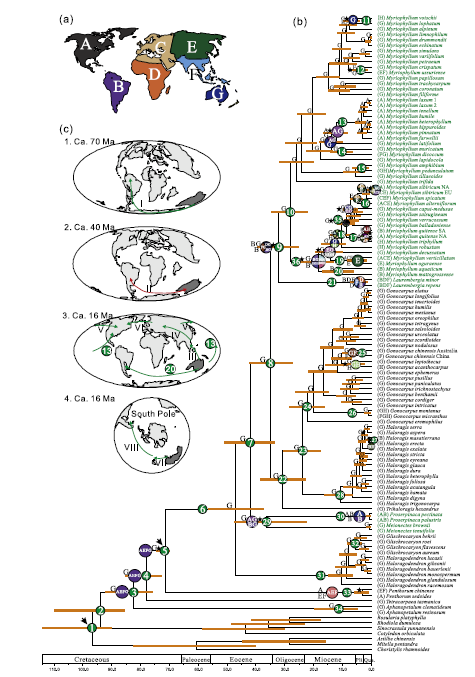Name:
Tell:
Email:
Organization:
Historical Biogeography and Diversification Patterns of Haloragaceae Revealed
2014-06-03
Haloragaceae are a dicotyledonous family in the order Saxifragales. It includes 8 genera and about 138 species with a cosmopolitan distribution. The centre of distribution is Australia, where 6 of the 8 genera and about 70% of the species occur. Haloragaceae’s life forms vary widely in the family including both terrestrial and aquatic genera.
A research team led by Professor WANG Qingfeng at Wuhan Botanical Garden investigated the historical biogeography of the family and the role of vicarianceand dispersal in shaping its current distribution. DNA sequences from ITS, matK and the trnK5' and trnK3' introns were obtained for 102 species representing all 8 genera of Haloragaceae for use in Bayesian molecular dating. Molecular dating wasconducted using two macrofossils as calibration points for the analyses. Biogeographic history was investigated using a Bayesian dispersal-vicariance analysis and a dispersal-extinction-cladogenesis model.
The results suggested that the earliest diversification of the extant Haloragaceae occurred in Australia during the Eocene (37.3-56.3 Ma). Early diversification of the family in the Southern Hemisphere was inferred as resulting from vicariance events among Australia andSouth America.
This research also indicated multiple out of Australia dispersal routes, primarily including (1)from Australia to Asia during the Miocene, with subsequent dispersal to Europe and North America; (2) from Australia to New Zealand, then to South America during the Miocene and Pliocene. Most of the inferred dispersal events occurred throughout the Miocene and later, and were biased towards the aquatic Haloragaceae lineages.
Results entitled “Historical biogeography of Haloragaceae: An out-of-Australia hypothesis with multiple intercontinental dispersals” were published in Molecular Phylogenetics and Evolution. This study was supported by a CAS XDA05090305 to QFW, a NSFC 31300182 to LYC, and a NSF DDIG0309123 to MLM.

Historical biogeography of Haloragaceae: (a) Chronogram of Haloragaceae obtained under a Bayesian relaxed clock model using combined ITS +trnK 5′ intron + matK + trnK3′ intron DNA sequence data. (b) Area delimitation in the biogeographic analysis. (c) Main dispersal routes of Haloragaceae.(Image by CHEN Lingyun)